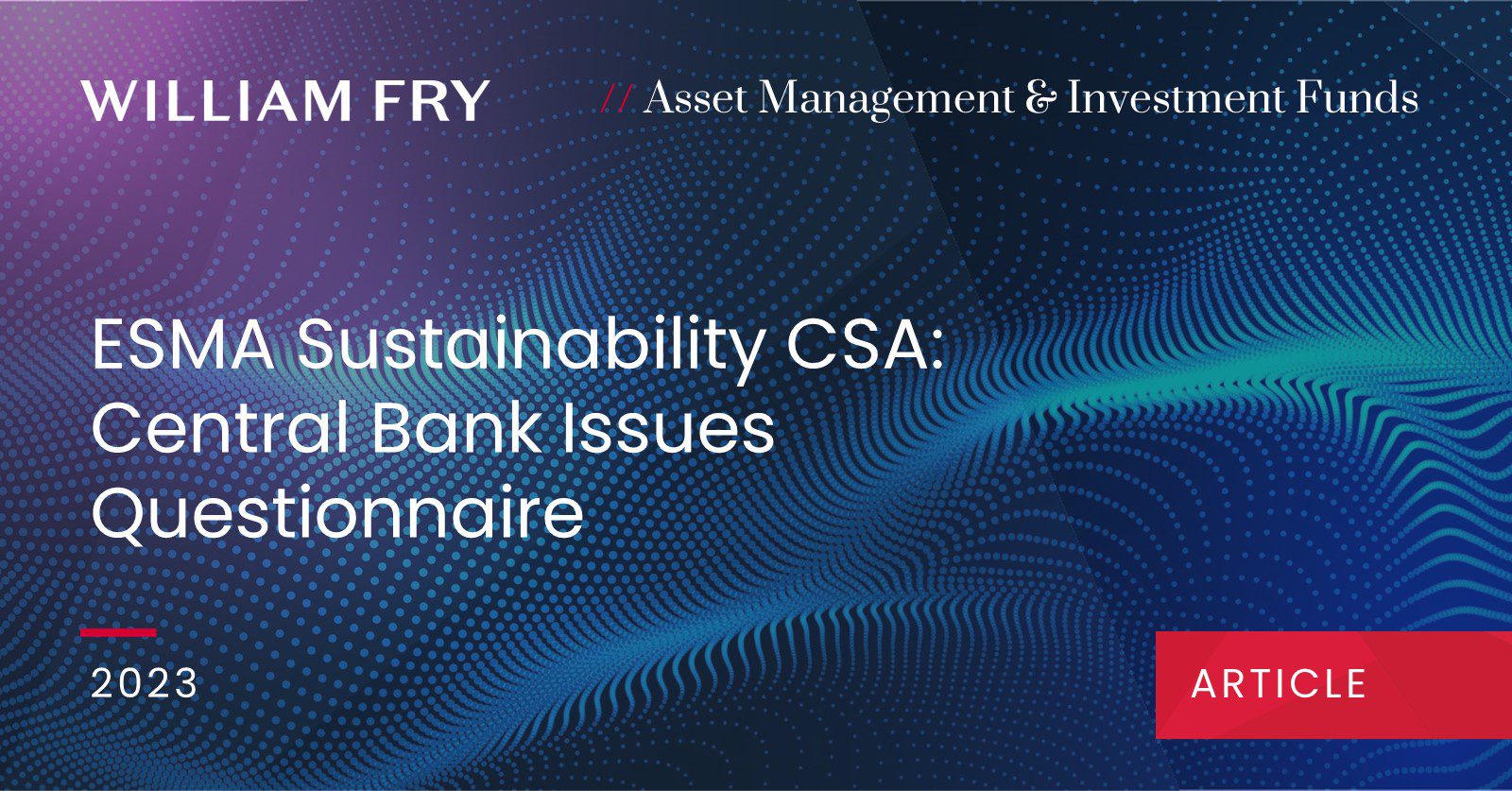On 6 July 2023, ESMA launched a CSA on fund managers’ compliance with SFDR, the Taxonomy and UCITS/AIFMD sustainability-related rules.
First-phase CSA engagement from the Central Bank began on 15 August 2023 with the issuance of a detailed questionnaire to those Irish fund managers selected for participation in the CSA. Analysis of the CSA questionnaire, which focusses on compliance with SFDR website and periodic disclosure rules and sustainability risk management rules, is set out below.
While not all Irish fund managers are in scope of the CSA, the questionnaire is a strong indication of regulatory focus and likely target areas for CSA findings which, as per previous actions, will likely issue to all fund managers in due course along with a requirement for gap analyses and action plans to rectify any gaps identified.
Sustainability Risk Integration
As part of the CSA, selected fund managers are required to provide policies, processes and procedures evidencing governance structures and operational systems in place for identifying, measuring, and managing the impact of environmental and social factors on investment returns i.e., sustainability risks.
Fund managers must also provide the time commitment of those responsible for managing sustainability risks, both as a percentage of their overall time commitment and of the fund manager’s total number of full-time equivalents (FTEs). Details must also be provided of those responsible for managing greenwashing risk, how it is defined, accounted for and how conflicts of interest which can give rise to this risk are managed.
Relevant requirements: senior management of both UCITS managers and AIFMs are responsible (under respective governing regimes) for the management of underlying funds’ exposure to sustainability risks, ensuring relevant functions are properly resourced with the necessary technical expertise and conflicts of interest arising from the integration of sustainability risks are identified and managed.
Comment: While considered by ESMA during the industry consultation process, neither UCITS nor AIFMD sustainability-related rules provide for the designation of a specific, qualified individual with a minimum time commitment to the management of sustainability risks of underlying funds’ investments. Fund managers can therefore, incorporate sustainability and greenwashing risk management into existing governance and organisational structures for fund risk management in accordance with the UCITS and AIFMD risk management rules. In respect of greenwashing risk, it may be of benefit to take note of the ESAs’ definition of greenwashing as set out in ESMA’s recent report on the topic. See briefing on ESMA’s report in our June 2023 update for further details.
PAI, remuneration and website disclosures
This part of the CSA focuses on remuneration, entity-level consideration of principal adverse impacts (PAIs) and maintenance of website disclosures.
Fund managers must evidence compliance with the requirement for remuneration policies not to encourage excessive sustainability risk-taking. For those managers which consider PAIs, either on a mandatory or voluntary basis, a link to the required PAI statement must be provided, along with evidence of translations of the summary section into relevant host Member State languages and disclosure of the degree of alignment with the Paris Agreement objectives. A description of the guidelines/procedures in place to ensure that sustainability related information published on the website is up to date must also be provided.
Relevant requirements: SFDR entity and product-level PAI consideration disclosure rules, remuneration transparency rules, website disclosure maintenance rules.
Comment: SFDR Level 2 (Article 9) requires the PAI statement to detail the degree of fund managers’ alignment with the Paris Agreement objectives and the PAI indicators used to measure such alignment. The ESAs’ first annual report on compliance with entity-level PAI disclosure rules (July 2022) highlighted low levels of compliance with these requirements and identified disclosures, by those that did comply, as vague, too high level, and lacking indicators used to measure portfolios’ decarbonisation paths. The ESAs positively cited alignment disclosures which include ‘credible decarbonisation objectives, upstream and downstream emissions, setting out scale and timeline for action to achieve the trajectories consistent with the Paris Agreement, alignment specific investments with carbon neutral trajectories’.
ESG labels, net-zero strategies and investor engagement
The product-level CSA questions focus on Article 8 and 9 funds’ use of ESG labels, net-zero/carbon neutrality claims and engagement strategies. Each of these topics featured heavily in ESMA’s progress report on greenwashing to the Commission in May 2023. The CSA seeks evidence of controls in place to ensure ESG claims can be substantiated, consistent use of ESG metrics and data, and data limitations do not impact achievement of ESG characteristics or objectives.
For funds with net zero or carbon neutral strategies, the CSA requests any disclosures as to asset coverage, time horizons and targets, emissions measurement methodologies, action plans, potential obstacles and associated mitigants and reference points for forecasting portfolio emissions.
For those employing engagement strategies, the CSA requires details of how product-level strategies differ from managers’ entity-level strategies as well as evidence of relevant disclosures e.g., PAI statements, engagement policies with milestones and outcomes, voting policies, any relevant engagement reporting or relevant statistics on voting and their outcomes.
Relevant requirements: website data disclosure rules (SFDR Level 2 Article 31-35 & 44-48)
Comment: responses will inform ESMA and NCAs as to the likelihood and extent of greenwashing across the funds sector, any evidence of which will be included in ESMA’s final report on greenwashing to the Commission, due by May 2024. In its May 2023 greenwashing progress report, ESMA sets out key risk areas and expectations for avoiding greenwashing. The progress report is a useful reference, both for avoiding this risk and meeting relevant regulatory expectations. See our June 2023 briefing for further details of ESMA’s May 2023 greenwashing report.
Fund names, target v actual sustainable/Taxonomy aligned investments and methodologies
The CSA requests details in respect of a particular fund/sub-fund under management, as selected and specified by the Central Bank in its CSA engagement with relevant fund managers. The focus of such fund-specific questions is on the name of the fund (whether it reflects the sustainable characteristics/objectives); any sustainable investment (including DNSH) methodology employed for the fund; compliance with website disclosure rules; and explanations of any differences (>5%) between pre-contractual minimum commitments to sustainable/Taxonomy aligned investments and actual levels of such investments along with any necessary corrective measures taken.
Specifically for Article 8 funds with sustainable investments and Article 9 funds, the CSA requires fund managers explain any adopted DNSH methods which do not take the mandatory PAI indicators into account as well as confirmation of the optional PAI indicators used for DNSH purposes. If the specified fund considers PAI at product level (in accordance with SFDR Article 7), the CSA also requests confirmation of whether the fund’s use of the PAI indicators for DNSH is consistent with its use of the indicators for the purpose of considering investments’ PAIs.
Relevant requirements/regulatory expectations: draft ESMA guidelines on fund names (see our May 2023 briefing for further details), ESMA May 2022 supervisory briefing on sustainability risks and disclosures, periodic sustainable/Taxonomy-aligned investment disclosures (SFDR Level 2 Articles 51, 55, 59, 62)
Comment: while not yet finalised, ESMA’s draft fund name guidelines require fund names not to be misleading and the use of ESG terms in fund names to be supported by the adoption of ESG characteristics or objectives. The fund name guidelines are expected to be finalised in early October this year. In its May 2022 supervisory briefing, ESMA confirmed that Article 8/9 funds’ periodic disclosures should ‘match (or fulfil)’ pre-contractual commitments and sustainable investment DNSH methodologies should at least include the mandatory PAI indicators under SFDR Level 2.
Next Steps
Fund managers in scope of the CSA have been given a four-week deadline for responding to the questionnaire. While the CSA is scheduled to run until Q3 2024, the Central Bank notes the deadline is necessary to facilitate efficient implementation of the CSA which, given the timeline, is expected to comprise several phases.
If you have any queries on the issues discussed in this article, please get in touch with the key contacts, any member of the Asset Management & Investment Funds team or your usual William Fry contact.


